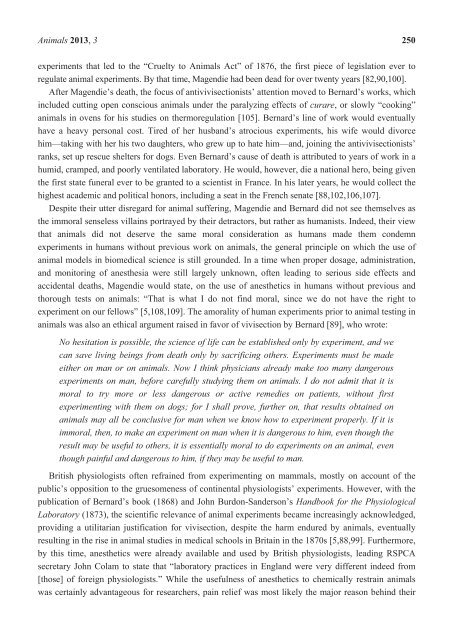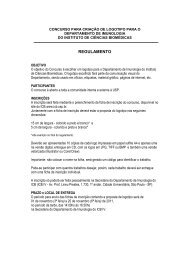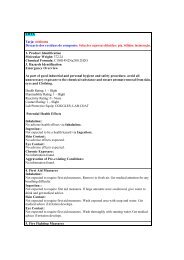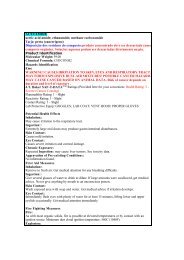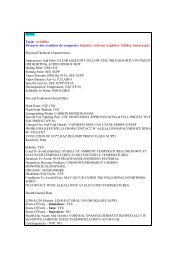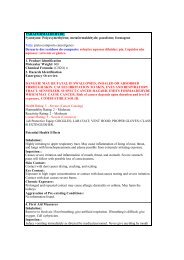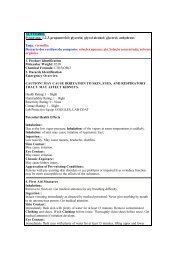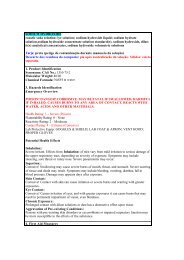Animal Experiments in Biomedical Research: A ... - MDPI.com
Animal Experiments in Biomedical Research: A ... - MDPI.com
Animal Experiments in Biomedical Research: A ... - MDPI.com
Create successful ePaper yourself
Turn your PDF publications into a flip-book with our unique Google optimized e-Paper software.
<strong>Animal</strong>s 2013, 3 250experiments that led to the “Cruelty to <strong>Animal</strong>s Act” of 1876, the first piece of legislation ever toregulate animal experiments. By that time, Magendie had been dead for over twenty years [82,90,100].After Magendie’s death, the focus of antivivisectionists’ attention moved to Bernard’s works, which<strong>in</strong>cluded cutt<strong>in</strong>g open conscious animals under the paralyz<strong>in</strong>g effects of curare, or slowly “cook<strong>in</strong>g”animals <strong>in</strong> ovens for his studies on thermoregulation [105]. Bernard’s l<strong>in</strong>e of work would eventuallyhave a heavy personal cost. Tired of her husband’s atrocious experiments, his wife would divorcehim—tak<strong>in</strong>g with her his two daughters, who grew up to hate him—and, jo<strong>in</strong><strong>in</strong>g the antivivisectionists’ranks, set up rescue shelters for dogs. Even Bernard’s cause of death is attributed to years of work <strong>in</strong> ahumid, cramped, and poorly ventilated laboratory. He would, however, die a national hero, be<strong>in</strong>g giventhe first state funeral ever to be granted to a scientist <strong>in</strong> France. In his later years, he would collect thehighest academic and political honors, <strong>in</strong>clud<strong>in</strong>g a seat <strong>in</strong> the French senate [88,102,106,107].Despite their utter disregard for animal suffer<strong>in</strong>g, Magendie and Bernard did not see themselves asthe immoral senseless villa<strong>in</strong>s portrayed by their detractors, but rather as humanists. Indeed, their viewthat animals did not deserve the same moral consideration as humans made them condemnexperiments <strong>in</strong> humans without previous work on animals, the general pr<strong>in</strong>ciple on which the use ofanimal models <strong>in</strong> biomedical science is still grounded. In a time when proper dosage, adm<strong>in</strong>istration,and monitor<strong>in</strong>g of anesthesia were still largely unknown, often lead<strong>in</strong>g to serious side effects andaccidental deaths, Magendie would state, on the use of anesthetics <strong>in</strong> humans without previous andthorough tests on animals: “That is what I do not f<strong>in</strong>d moral, s<strong>in</strong>ce we do not have the right toexperiment on our fellows” [5,108,109]. The amorality of human experiments prior to animal test<strong>in</strong>g <strong>in</strong>animals was also an ethical argument raised <strong>in</strong> favor of vivisection by Bernard [89], who wrote:No hesitation is possible, the science of life can be established only by experiment, and wecan save liv<strong>in</strong>g be<strong>in</strong>gs from death only by sacrific<strong>in</strong>g others. <strong>Experiments</strong> must be madeeither on man or on animals. Now I th<strong>in</strong>k physicians already make too many dangerousexperiments on man, before carefully study<strong>in</strong>g them on animals. I do not admit that it ismoral to try more or less dangerous or active remedies on patients, without firstexperiment<strong>in</strong>g with them on dogs; for I shall prove, further on, that results obta<strong>in</strong>ed onanimals may all be conclusive for man when we know how to experiment properly. If it isimmoral, then, to make an experiment on man when it is dangerous to him, even though theresult may be useful to others, it is essentially moral to do experiments on an animal, eventhough pa<strong>in</strong>ful and dangerous to him, if they may be useful to man.British physiologists often refra<strong>in</strong>ed from experiment<strong>in</strong>g on mammals, mostly on account of thepublic’s opposition to the gruesomeness of cont<strong>in</strong>ental physiologists’ experiments. However, with thepublication of Bernard’s book (1868) and John Burdon-Sanderson’s Handbook for the PhysiologicalLaboratory (1873), the scientific relevance of animal experiments became <strong>in</strong>creas<strong>in</strong>gly acknowledged,provid<strong>in</strong>g a utilitarian justification for vivisection, despite the harm endured by animals, eventuallyresult<strong>in</strong>g <strong>in</strong> the rise <strong>in</strong> animal studies <strong>in</strong> medical schools <strong>in</strong> Brita<strong>in</strong> <strong>in</strong> the 1870s [5,88,99]. Furthermore,by this time, anesthetics were already available and used by British physiologists, lead<strong>in</strong>g RSPCAsecretary John Colam to state that “laboratory practices <strong>in</strong> England were very different <strong>in</strong>deed from[those] of foreign physiologists.” While the usefulness of anesthetics to chemically restra<strong>in</strong> animalswas certa<strong>in</strong>ly advantageous for researchers, pa<strong>in</strong> relief was most likely the major reason beh<strong>in</strong>d their


